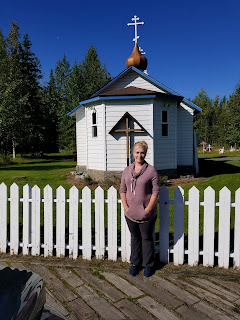Whittier Alaska
A couple of years ago Richard and I decided to spend out
anniversary at the Historic Anchorage Hotel, Anchorages “haunted hotel”. In the
morning we were talking about what to spend the day doing and we decided why
not take a drive out to Whittier. One might think that taking a drive to a
small town about 60 miles away would be an easy task, but Alaska is not an easy
place to get around. Much of our state is off the road system, meaning it
cannot be accessed by car. Now Whitter can be driven to but there is a catch,
in order to get to the small town you must drive through a one-way train
tunnel.
Whittier History
Whittier Alaska is located on the west side of Prince William
Sound, it sits in an area that was traveled for many years by Native Alaskans,
gold miners, traders and then the U.S. military.
As relations between Japan and the United States began to
decline in the late 1930’s the United States began to see, that Alaska was strategically
important being located between Japan and the Western United States. The military
began to increase military presence and locations within Alaska. On June 3 and
4th 1942 Japan attacked Dutch Harbor in Alaska making it obvious
that the Japanese had the ability to attack other harbors within Alaska. The
military gave high priority to improving railroads within Alaska in order to
more easily move materials and supplies for the war effort in Alaska. The Army then
constructed a military facility complete with a port and railroad; this was
Camp Sullivan in Whittier, which operated from 1943 to 1960 in order to supply
the region with military support, the port served as an entrance for United
States soldier entering Alaska. This military port was important to the
military in both WW2 and during the Cold War.
In 1953 the Buckner Building was constructed by the military,
it was the largest building in Alaska and was often referred to as “the city
under one roof”. This building is over 270,000 square feet, six stories high
with two basement levels. It had housing for 1,000 military members and its amenities
included a cafeteria, a movie theatre, post office, PX, library, its own radio
station, a gym, a pool, a hospital, and even a jail. The building was named
after General Simon Buckner, the highest-ranking United States Pacific Theater
military officer to be killed in action during WW2. The building was designed
to function as a fully functional military post under one roof.
During the same time the Buckner building was being built construction
was underway for a 14-story building also in Whitter, the Hodge building was
completed in 1957 and started as a military housing complex before being
renamed Begich Towers in memory of Congressman Begich whose plane disappeared
in the area. This building is now condominiums where today the majority of
Whittier residents live, it is completely self-contained, with a general store,
a doctor, and tunnels to the school. Whittier residents need not ever leave the
building in the cold Alaska winters if they do not chose to.
There are a few other buildings in Whitter; these include
some shops along the waterline for tourists who come in on the cruise ships, a
few houses scattered about, a small hotel, general store and restaurant along
with a rather impressive museum all pretty much in the same two buildings next
to each other.
Our day in Whittier
On our day trip to Whittier we made the drive, pulled up and
paid our toll to go through the tunnel and then pulled into the waiting lane,
cars line up and wait until the tunnel is open for your direction of traffic. The tunnel is very narrow and dark but before long you see
sunlight at the end and pull into a town time forgot. Richard’s first thought was it looks an awful
lot like the Eastern Block countries he visited in Europe and I suppose that is
true given the difficulty and steep cost of bringing materials in I doubt it
has changed much since being built.
We made our way to the Buckner building; it has been listed
as one of the most haunted spots in Alaska so of course I had to see it. The
military moved out of the building in 1960 and it sustained some damage in the
1964 earthquake, it has been standing empty ever since. The building has
boasted many ghost stories from floating orbs to full apparitions of long dead
military members and civilians alike. You can no longer explore inside the building
as it is considered very dangerous and sadly has been vandalized, the floors
are full of water and the walls full of asbestos, there is a high fence and big
no trespassing signs, but you can pull up next to it and get a feel for the
building.
Begich towers also has tales of its own ghosts, with stories of
phantom noises and a resident ghost who likes to wander the halls and whistle.
We had lunch in the only restaurant open, since we went in
February none of the little seaside shops were open, but we found a small place
that looks just like it must have looked in 1960, it was clean, inviting and relatively
cheap for lunch, from there we wandered next door to the museum, a pretty impressive
collections of historical items and stories for a small donation of $5.
This town and its residents living and deceased were
friendly and welcoming to us, we enjoyed our trip and would definitely go back
to explore a little more.












Comments
Post a Comment